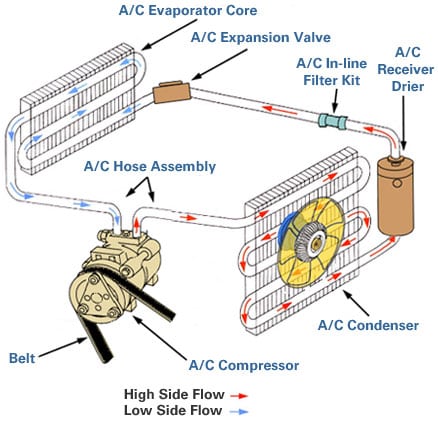We’ve all been there. You pull out of the driveway and see a mysterious puddle. At first, you think that maybe it’s from some other car and you just happened to be parked above it, but eventually, you’ll realize that it’s your vehicle that is leaking. How do you determine what is leaking so you can then figure out how to fix it?
There are many things that can leak onto the ground from your car. Some are worse than others. The six most common leaks are:
1- Engine oil,
2- Antifreeze (coolant),
3- Transmission fluid,
4- Gear fluid (differential, hypoid),
5- Shock absorber oil, and
6- Water (not antifreeze).
We will start with the easiest first.
Water
If the puddle of whatever is leaking leaves little or no residue or stain after evaporating, and is under the engine compartment or major components of the exhaust system (catalytic converter, muffler, exhaust tip), then it’s most likely just water that’s been condensing as temperatures around the engine compete with the surrounding atmosphere.
This should only be happening when the outside temperature is low or when the air conditioner has been run for long periods in the heat. Regardless, if the leak is just water condensation, then you have no worries and things are OK. Be aware that if this happens frequently and the water does not evaporate relatively quickly, it can hasten rust in areas like your exhaust pipes, muffler, etc.
Engine oil
One of the more common leaks, or at least the most-often suspected leak, is engine oil. Leaks here will usually take place around the oil pan, specifically its gasket or drain plug. Engine seals can also begin to fail over time and leaks may appear when the engine is cold and has been sitting. These will be around the main seals of the engine where the engine block, heads, and major components come together.
To find out if it is oil that is leaking, using rubber gloves (preferably latex surgeon’s gloves), dip your fingers in the puddle and look at it closely. Is it black or dark brown? Does it feel relatively “slick” and viscous (sticky)? Does it smell like engine oil? If your vehicle is losing oil over time, this may be the cause.
Depending on the leak location, an oil leak can be relatively easy or very difficult to repair. Whatever you do, do not use stopleak on engine oil leaks. Some mechanics do recommend using small amounts of UV dye to determine the exact leak location. Some leaks are not as bad as others and can be left alone until major maintenance intervals will make them easier to repair, such as timing belt changes.
Coolant / Antifreeze leaks
Another common leak is the engine’s coolant (aka antifreeze). This will usually be bright green or blue in color, depending on the type. It’s referred to as antifreeze because it will be about 50 percent water and 50 percent antifreeze solution – a chemical to prevent freezing in very cold temperatures. Obviously, a vehicle with no liquid cooling system will not have antifreeze leaks – and you thought the old VW Bug and Corvair had no saving graces.
Most coolant leaks will be very obvious due to the color of the leaking fluid. Some manufacturers use odd colors like red, orange, or even yellow. Some are even clear. Whatever they are, they will have a distinctive “sweet” smell to them and watery texture that gives them away. Be aware that antifreeze is a serious poison that can kill you or animals if ingested!
The leaks in your cooling system will nearly always be around the radiator or its hoses. Most other leaks will be internal to the engine and will be determined by signs other than coolant on the ground. Read more about that here.
Fixing a coolant leak depends on where the leak is coming from and may be as simple as replacing worn hoses and ties.
Transmission fluid leaks
Vehicles with an automatic transmission will have fluid that is separate from the engine oil while those with a standard transmission will most likely use the engine oil for lubrication. In the latter case, this just extends where you look for engine oil leaks.
Automatic transmission fluid is usually red in color and will have a texture similar to engine oil, but with less viscosity. Some transmissions use non-specific oils such as gear oil (see below).
Transmission fluid leaks will usually be from the transmission’s pan or collector, output shaft seals (for rear drive) and axle seals (front-wheel drive). Transmission leaks left unrepaired will eventually lead to slippage and ultimately failure. The fix is usually to replace the leaking seal, flush the fluid, and replace any filter(s) and screen(s) before adding new fluid.
Differential or hypoid leaks
This fluid is called by several names, including the above or just “gear oil.” It has a very thick, honey-like appearance and a heavy, greasy smell to match. It is usually dark brown or very black in color, depending on its age, and most mechanics will be able to identify it purely from its smell.
Gear oil most often leaks from manual transmissions, wheel bearing seals, and the rear differential on rear-wheel drive or four-wheel drive vehicles.
Gear oil is also used in hydraulic power steering systems. Not all vehicles use true gear oil in their power steering systems, however, so check before you refill. Power steering leaks will usually be around hose connections to and from the pump.
Shock absorber oil
Many of today’s vehicles feature oil- or gel-filled shocks on their suspensions and many after-market additions will also be oil or gel. When these fail, they usually leak their fluids out. This can appear to be brake fluid, due to the general location, but will be different colors depending on the type of shock absorber in question. Most of the time, a look at the shock will tell you whether it’s leaking as a leaking one will not hold weight well and will have fluid covering it from the “seal” (top, center, or bottom) down. The only fix is to replace the shock.
Brake fluid
Left off our list because it’s a different animal in terms of vehicle safety and maintenance, leaking brake fluid is bad news. If you see or suspect a brake fluid leak, DO NOT DRIVE THE VEHICLE. Brake fluid is similar in appearance to engine oil, but lighter in color. It should not be “dirty” at all unless it’s come into contact with something after leaking out. Common brake fluid leak locations are at the master cylinder and at connections to calipers/drums. Leaking brakes should be fixed immediately.








